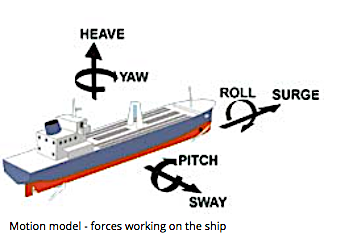Chapter 4: My Workplace
In this chapter you will ….
- Learn about different crew roles and duties
- Learn about typical equipment found on the bridge
- Learn words and phrases related to the weather
Your sailing experience has given you the opportunity to participate in different types of work on board- from tank sounds, ship maintenance and deck work to berthing and unberthing, pilotage operations, and port and cargo operations.
This chapter will focus on the officers' duties on the bridge and the different roles of the navigational watch as well as the equipment used. After working with this, you should be able to describe the roles and duties of the navigational watch and the equipment used. Good seamanship and the importance of accurate communication in English are emphasised throughout the chapter.
Manning
The ISM Code states that "each ship is manned with qualified, certificated and medically fit seafarers in accordance with national and international requirements" (ISM CODE, § 6.2). It is the shipping company's responsibility to ensure that all crewmembers in the company's fleet meet the requirements.
You can read more about the safe manning of vessels in SOLAS Chapter V § 14, or read the regulation Manning on Norwegian ships here. The British Maritime & Coastguard Agency's guide on safe manning is found here.
Navigation and navigational aids
The regulation for navigation and navigational aids for ships and mobile offshore units (Norwegian Maritime Authority , 2014) applies to all Norwegian cargo ships and recreational crafts of 24m LOA, passenger ships, mobile offshore units and barges. You can read the regulations here.
The Crew
Manning
How a vessel is manned is critical to its successful operation. The safe operation of a ship is just as dependent on the competence and actions of the crew as it is on the physical state of the ship.
When out at sea, it is crucial that the crew's combined competence covers everything from navigating the vessel in all kinds of weather, maintaining radio contact, and cargo handling to treating crewmembers that have been injured and, in such an event, even fighting fires.
Crew roles and key responsibilities
The crew is divided in different departments, each with an officer that reports to the captain. Below, you see an example of the ranking on board a somewhat larger vessel:
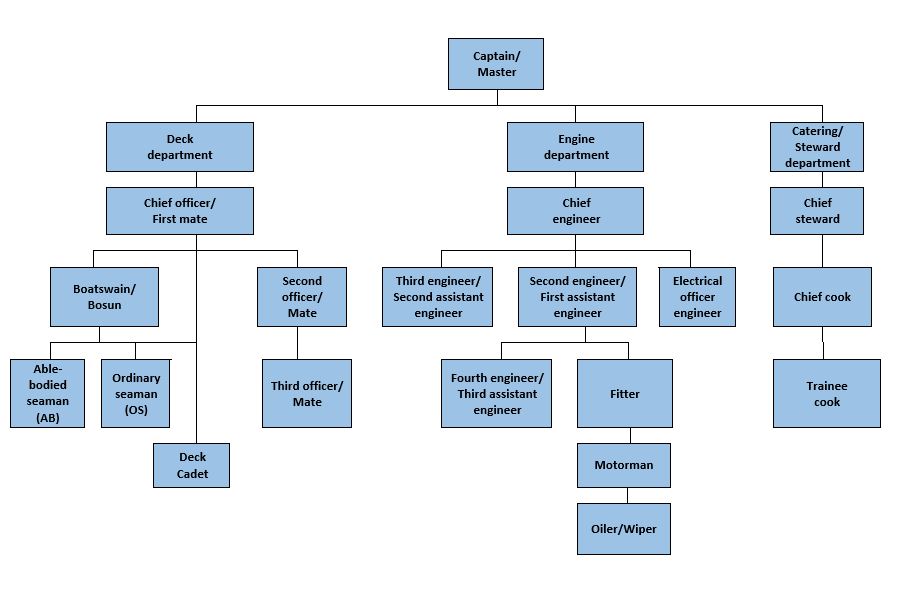
The size of the departments and the number of management levels on board a vessel is dependent on the ship's type, size and cargo. A large cruise ship will have larger departments, maybe even a hotel department with a staff Captain who has a designated responsibility for the crew, which can be quite large on such a vessel. On the other hand, a small fishing vessel has less of a difference between those in leadership roles and the rest of the crew, where all hands take part in the deck work, even the Captain, which would be unthinkable on a larger vessel.
Technical English for Deck Cadets (Seagull AS, 2011) explains the responsibilities and duties of the officers and ratings on board.
Master
The Master of the ship, or the Captain, is in command of the ship. She has the overall responsibility for the safe navigation of the ship, the safety and protection of the crew and passengers, the safe delivery of the cargo, and the efficient maintenance of the ship's equipment. She ensures discipline and smooth operations on the ship by delegating responsibility to qualified officers and members of the crew and by monitoring their performance.
Chief Officer
The Chief Officer is in charge of the deck and cabin departments. He is responsible for loading, discharging and care of the cargo in port and at sea; the general maintenance of the deck and accommodation areas; and maintaining the navigation and safety equipment. He also assists the Master in the general administration on the ship. While at sea the Chief Officer normally keeps the 4-8 morning and evening navigation watch.
Second Officer
The Second Officer is often called the Navigating Officer and is responsible for the upkeep of navigational charts, navigational equipment and publications. He plans the voyage under the guidance of the Master and plots the course on the chart before the ship sails. At sea he keeps the navigational watch from 12-4 morning and night. In port he keeps alternate cargo watch to assist the Chief Officer in cargo operations.
Third Officer
The Third Officer is responsible for the maintenance of the ship's safety equipment, including the fire- fighting and the life-saving equipment, under the guidance of the Chief Officer. He keeps the 8-12 mornings and evening navigational watch at sea. In port he keeps the cargo watch, alternating with the Second Officer to ensure smooth cargo operations.
Deck Cadet
The trainee or Deck Cadet works under the guidance and command of the Chief Officer. All ships have a specialized training program and work schedule for hands-on job experience for the cadets.
Bosun
The Bosun, or Boatswain, is in charge of the Deck Ratings or crew. The Bosun takes orders from the Chief Officer for the maintenance work on deck and allocates work to the Deck Ratings.
Chief Engineer
The Chief Engineer is the Head of the Engine Department. She has the overall responsibility for the maintenance and smooth operation of all machinery including the engine room and deck machinery, electrical and electronics systems, mooring equipment, deck pumps and cranes. She is also responsible for the ordering and storing of spares and stores required for the upkeep of the machinery.
The Chief Engineer estimates the fuel oil consumption of the main engine during the voyage and ensures sufficient 'bunker' or fuel oil is available for the forthcoming voyage.
Second Engineer
The Second Engineer is in charge of engine room machinery and personnel and assists the Chief Engineer in the maintenance of all machinery in the engine room and critical machinery on deck. He delegates various jobs to the Engineers and Engine Ratings and monitors their performance. He keeps the 4-8 morning and evening Engine Room watch in a manned ship and Day work (8 - 17) in an Unmanned Machinery Space (UMS) ship along with other engineers.
Third Engineer
The Third Engineer is responsible for auxiliary engines and other electrical equipment. He also keeps the Engine Room Watch from 12-4 morning and night and assists in the general maintenance of the Engine Room.
Fourth Engineer
The Fourth Engineer is responsible for auxiliary machinery such as purifiers, pumps and related equipment. He is responsible for daily bunker calculations. He usually keeps the 8-12 morning and evening Engine Room Watch
Electrical Officer
The Electrical Officer is responsible for the maintenance of electrical equipment onboard the ship, including radio, navigation and safety equipment.
Fitter
The Fitter assists in the general maintenance of the Engine Room. The various repair jobs including welding and gas work are usually carried out by the Fitter.
Engine Ratings
Engine Ratings assist in general maintenance and cleaning and contribute to smooth operations in the Engine Room.
Catering Department
On cargo ships, the Chief Cook and the Stewards form part of a Catering Department team with the responsibility for food preparation and service and general accommodation area cleanliness. They work under the guidance of the Master. On Passenger Ships the Catering Department will have more personnel to meet the requirements of the passengers.
The bigger the vessel and the more complex the work on board, the more need we have for written procedures specifying the work and responsibilities on board. In 2017, the Norwegian Maritime Authority laid down new regulations on safety management also for small cargo ships, fishing vessels and passenger ships. You can read the regulation here.
Exercises
-
Train yourself in the ThingLink found here.
-
Describe the ranking of the crew and the different responsibilities on the ship you last worked on.
a) Set up a diagram showing the different ranks and ratings on board. Pay attention to what the Norwegian ranks of overstyrmann and førstestyrmann are in English. Make sure you know the right pronunciation and the correct English-Norwegian translation.
b) Describe the hierarchy and the roles of the different crewmembers to a partner by using the diagram
c) Read the following text from Mareng: The crew and its task from Unit 9 On the watch. Write a short summary, where you, in keywords, list the different tasks of the different ranks. Add also other things you might find important. Tips: You can download entire Unit 9 here. -
Crew Bingo
Teacher tip: Here the students are to each randomly receive a rank or rating title. They are not to show which rank or rating they have received to anyone else. Using their prior knowledge and what they have just read/learned about ranks and ratings, each student should come up with a description of that particular rank or rating; this can be who this rank/rating would typically answer to on board a vessel or the responsibilities and duties most commonly associated with the rank they have received. After they have come up with their description, the students should canvass the classroom sharing their descriptions with each other and filling in the names of their classmates in the appropriate squares on their "bingo sheets" (see the link below). In order to get a "Bingo" on their "Bingo Sheet", students must write the names of their classmates next to the appropriate rank or rating based on the descriptions they have heard. The person who is able to fill in their "Bingo Sheet" correctly and completely first is the winner. Here's the bingo sheet.
Shift work and watch schedules
The most common shift schedules or rotations for the Norwegian seafarer are 2:2 or 4:4, two weeks on and two off, or four weeks on and four weeks off, but this can differ from company to company, the size of the vessel and whether the work is season based or not.
Depending on whether the vessel is at sea sailing or laying at anchor or in port, the crew stand different watches.
In order to maintain continuous operation of a vessel, the crew is divided into watches. In a three-watch system, the crew is divided into three groups, and the workday divided into six watches, each four hours long, as you can see here:
| First watch | 2000-2400 |
| Middle watch | 0000-0400 |
| Morning watch | 0400-0800 |
| Forenoon watch | 0800-1200 |
| Afternoon watch | 1200-1600 |
| Evening watch | 1600-2000 |
In some cases, the watch from 1600-2000 is split in two to facilitate feeding the entire crew a larger meal over a short period of time. These two short watches are sometimes referred to as the first and second dogwatch. When translating the term dogwatch to Norwegian directly we get "hundevakta" which in Norwegian refers to the watch between 0000-0400 not to be confused with the English dogwatch.
Exercise
Set up a table with the shift and watch schedule you were part of last. Reflect on the possible advantages and disadvantages with this arrangement.
The Navigational Watch and Bridge Team Management
The crew manning a modern vessel must be able to work as a team to ensure a safe voyage. Those crewmembers tasked with navigational watch duties have an enormous responsibility when working together as the bridge team.
So, why a team? The fact that several heads think better than two, eight eyes see better than four and numerous other human factors, makes the establishment of a bridge team, amongst other things, a matter of safety.
According to the International Chamber of Shipping's Bridge Procedures Guide, which is a widely acknowledged guidance on safe bridge procedures, the "bridge team is established so the most effective use can be made of available manpower in order that established work procedures are followed, risk is minimised and ships are navigated safely" (2016).
However, putting people together on the same bridge does not automatically make a team. Therefore, both the ability and the desire to be a good team member is crucial, and it is important that the bridge team work together closely. This thought must be applied within a particular watch, but also across watches as decisions made on one watch may influence another watch. Additional reading about management of the bridge team is found here.
Communication is key to success. This is decisive both within the watch, when handing over the watch, but also in contact with the engine room and all other operation areas on the ship. In a globalized industry like the maritime industry, people from all over the world are working together. This in one of the reasons for the STCW Code requirement of adequate knowledge of written and spoken English. Both internal and external communication needs to be understood and should be in a common language for all relevant team members, oftentimes English. This common work language becomes a lingua franca, a language used by people when they do not share the same first language.
Officer of the Watch
The Officer of the Watch, OOW, is the Master's representative on the bridge and is at all times responsible for the safe navigation of the ship in compliance with STCW and COLREGs. The OOW should comply with the SMS's requirements as the standing and daily orders of the Master. According to Bridge Procedures Guide, the primary duty of the OOW is to maintain a safe navigational watch at sea or at anchor, which requires ensuring:
- Compliance with the Company's navigational policies and requirements;
- Effective watch handovers;
- Management of the bridge team;
- Keeping a proper look-out;
- Familiarity with the bridge layout and equipment;
- Familiarity with bridge procedures;
- Maintaining situational awareness;
- Surveillance of the ship;
- Execution of the passage plan;
- Navigation and control of the vessel;
- Collision avoidance in compliance with the COLREGS;
- GMDSS watchkeeping;
- Compliance with environmental requirements;
- Monitoring the performance of navigational equipment;
- Recording bridge activities;
- Management of emergency situations;
- Security awareness (International Chamber of Shipping, 2016)
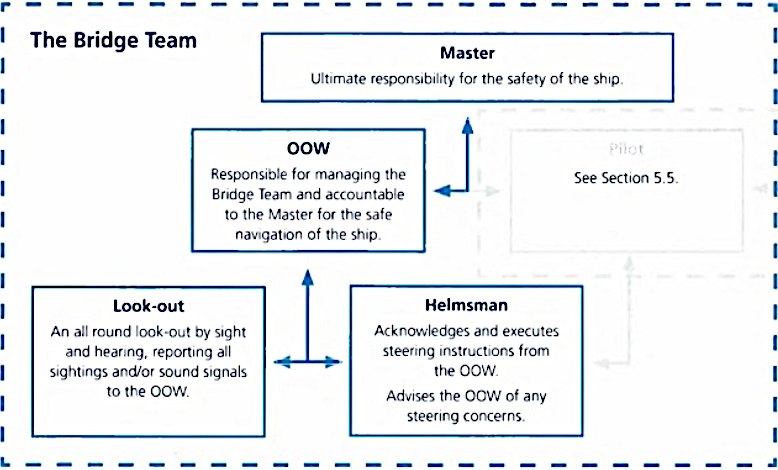
Exercises
-
In your opinion, what qualities do you find most important in a colleague? Include arguments.
-
Give some scenarios where clear and concise communication is important on the navigational watch.
-
Why is communication key to success?
-
In groups, divide the text within the group and read sections of the text Bridge Team Management. Write keywords from the passage you read. By using the keywords, explain the section to the rest of the group. Take turns. Can you come up with some examples where problems/accidents have occurred because communication was unsuccessful.
SMCP in use: Standard Wheel Orders and Handing over the Watch
As an OOW, you will be required to know certain wheel orders by heart. In addition, when a watch is handed over, the officer of the watch should brief the relieving officer on a number of matters. In IMO's Standard Marine Communication Phrases, we find the correct vocabulary and phrases covering a variety of different situations. There are times when a navigational situation requires the Captain to take over the watch from the Officer on watch; According to SMCP, the Captain then says: "I have the watch now" and the OOW replies: "You have the watch now." An example like this, where the order is repeated, is very important to avoid misunderstandings and prevent dangerous situations.
When wheel orders are given, the helmsman should repeat them and the OOW should ensure that the orders are executed correctly and immediately. If the vessel does not answer the wheel, the helmsman must report immediately, and all wheel orders should be held until countermanded ( (Sjøfartsdirektoratet, 1999)
Let us take a look at some of the standard wheel orders, compass course steering and what to say when you are handing over the watch.
Standard wheel orders
| Order | Meaning | Norwegian |
|---|---|---|
| Midships | Rudder to be held in the fore and aft position | Midtskips |
| Port five | 5• of port rudder to be held | Babord fem |
| Port ten | 10• of port rudder to be held | Babord ti |
| Port twenty | 20• of port rudder to be held | Babord tjue |
| Hard-a-port | Rudder to be held fully over to port | Hardt babord |
| Starboard five | 5• of starboard rudder to be held | Styrbord fem |
| Starboard ten | 10• of starboard rudder to be held | Styrbord ti |
| Starboard twenty | 20• of starboard rudder to be held | Styrbord tjue |
| Hard-a-starboard | Rudder to be held fully over to starboard | Hardt styrbord |
| Ease to five – ten – fifteen – twenty – twenty-five | Reduce amount of rudder to 5• (10, 15, 20, 25) and hold | Slakk til fem |
| Steady | Reduce swing as rapidly as possible | Støtt |
| Steady as she goes | Steer a steady course on the compass heading indicated at the time of the order. The helmsman is to repeat the order and call out the compass heading on receiving the order. When the ship is steady on that heading, the helmsman is to call out "Steady on ... " | Støtt så |
| Keep buoy/mark/beacon on port side | Hold bøye/merke/stake på babord side | |
| Keep buoy/mark/beacon on starboard side | Hold bøye/merke/stake på styrbord side | |
| Report if she does not answer the wheel | Meld fra visst hun ikke lystrer roret |
Compass course steering
Sometimes, the officer on watch requires the course to be steered by compass. There is a specific way of stating a compass course; each numeral is said separately, including zero. When the order is given, the helmsman should repeat it, and steadily bring the vessel to the course ordered. When the vessel is on course, the helmsman will say it out loud; Steady on..."
| Order | Course to be steered |
| Port, steer one eight two | Port, 182• |
| Starboard, steer zero eight two | Starboard, 082• |
| Port, steer three zero five | Port, 305• |
Handing over the watch
During a change of watch, there are several important things to remember. In section B1.1 in the Standard Marine Communication Phrases, you find how to brief on
- position, movement and draft
- traffic situations in the area
- navigational aids and equipment status
- radio communications
- meteorological conditions
- standing orders and so on.
A checklist like the one below is often used when there is a change of watch.
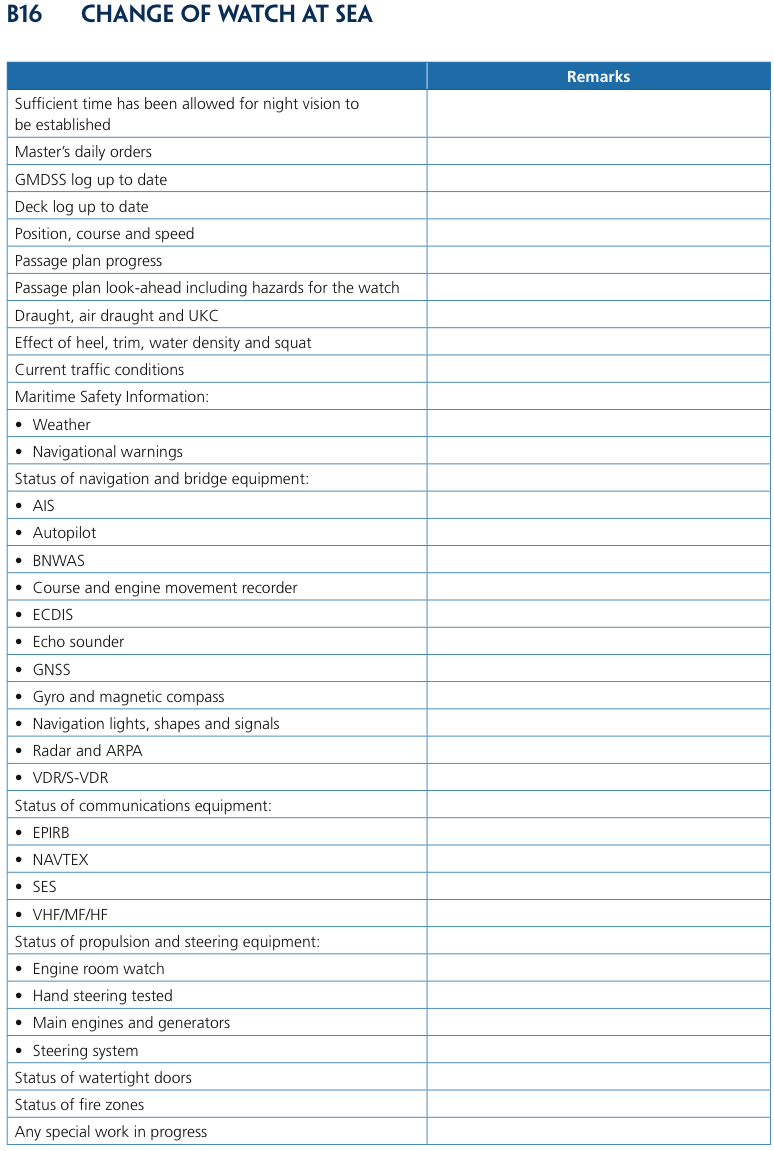
(International Chamber of Shipping, 2016)
It is vitally important that all necessary information is clear and unambiguously communicated. Closed loop communication, when a message is repeated, is therefore strongly encouraged to avoid misunderstandings. Far too many accidents have occurred due to miscommunication, and repeating orders and messages after they have been heard plays an important role in successful communication.
Let us look at how a watchkeeping handover should be executed. Remember, positions are always said one digit at the time, and 0 is zero.
OOW: What is present position?
Helmsman: Present position is ....
OOW: Present position is .... (repeats)
What is present course?
Helmsman: Present course is... degrees
OWW: Present course... degrees (repeats)
Exercises
-
Additional reading: Communicating positions over the radio, and other important expressions.
-
Positions
Write three positions each (individually). Read your positions to your partner. S/he should be able to write down the positions while you read it. -
In pairs, Use SMCP On-board communication phrases - Briefing on position, movement and draft (B1-1.1, or pp. 138-139 in Maritime standarduttrykk) and External communication phrases -Navigational assistance service (A1-6.2.2 or pp. 118-121 in Maritime Standarduttrykk), and write an exchange of dialogue where you ask about the following:
- Present position
- Present course
- True course
- Speed over ground
- Draft
- Altering of position
- Entering area/fairway
Act out the dialogue three times.
The Bridge
The bridge is the heart and head of the ship and is usually located in the superstructure. This is where the ship is steered and where the important navigational decisions are made. As mentioned earlier, an effective and well-functioning bridge team is of great importance. Where Bridge Team Management (BTM) focuses on the human resources available, Bridge Resource Management (BRM) is a process of using all of your available resources during critical operations, including [all] resources, not only the human element. Amongst these resources are of course the equipment and navigational aids found on board. The navigation and communication equipment is located on the bridge, and communications are provided to the engine room, accommodation, steering gear room, and other parts of the ship.
Bridge equipment
What kind of equipment found on the bridge depends on the ship type and its size, but some things are on all kinds of vessels. Generally, we will find
- GPS navigation device, and ECDIS chart system
- GMDSS-components
- radar with ARPA
- echo sounder
- wheel/autopilot system, compass and heading devices
- navigation light, sound and signalling equipment.
Take a look at this video where you can get a closer look at the navigation bridge of a large container vessel.
One of the first simulator exercises you had when you started your education this year, was a bridge familiarisation-exercise. Why do you think the instructors choose to start with this? As you know, one cannot successfully navigate a voyage if you do not know how to use and read the equipment correctly. Therefore, take the bridge familiarisation exercises in your bridge simulator-course seriously, and study the specifications and data sheets for the equipment in use. A typical checklist for familiarisation with the bridge equipment is like the one you can see on this file.
B3 Familiarisation With Bridge Equipment.pdf
As stated in Ship Knowledge (van Dokkum, 2013, s. 177), there is an ongoing development of integrated bridge systems aimed to improve operation. An integrated bridge can be stand alone items that are linked via keyboard, video and mouse switching. When the items are capable of performing together, we call it multifunction systems. A network system is required based on the computer system, and the sensor information is shared on all workstations. Of course, selections of a specific function can be made on each workstation.
An example of a bridge layout is found here.
One can divide the bridge layout into six different categories:
- Engine control console
- Steering console
- Navigational console
- Aids to navigation console
- GMDSS
- Safety communication console (Seagull AS, 2011)
Exercise
Before you read any further, what kind of equipment would you place under the different categories?
The following is a concise explanation of the different equipment (ibid.)
The Engine Control Console
As the name suggests, the equipment here controls the main engine and consists of
Telegraph console – used to adjust the vessel's speed from the bridge to the main engine control stand.
RPM indicator/tachometer – gives information about the main engine's revolutions per minute (RPM)
UMS alarms – UMS stands for Unattended Machinery Space, and this panel indicates the status of the alarm in the engine room when it is unmanned
The Steering Control Console
This console provides controls to the steering gear and consists of
Gyrocompass and repeaters – Used to find the ship's direction and true North. Repeaters are found in the steering console and bridge wing and must be present for emergency steering.
Magnetic compass – Not much used nowadays, only to control the gyro. It works in conjunction with the earth's magnetic field, as opposed to the Gyro compass which is not obstructed by this.
Auto pilot – Used in open seas for automatic steering. The intended course is pre-set, and the helm is adjusted automatically to maintain the pre-set course. A combination of the hydraulic, mechanical and electrical systems makes this remote steering possible, allowing the ship to sail on track with a planned route from ECDIS.
Rudder angle indicator – Provides the rudder degree angle to starboard or port when the wheel is moved. The rate of turn and rudder angle is shown on the display.
Navigational Console
This console provides basic controls for navigation, and can consist of, but is not limited to,
RADAR system – an acronym for Radio Detection and Ranging. RADAR is an electronic system that sends out wave pulses that are reflected back by an object within its range. This provides bearing and distance for collision avoidance. There are two main types, X-band and S-band. The radar is used for determining the distance of the ship to land, other ships, or other objects at sea. The Automatic Radar Plotting Aid (ARPA) shows the course and speed of other vessels and objects in the vicinity, Closest Point of Approach (CPA), and Time to Closest Point of Approach (TCPA)
Global Positioning System (GPS) receiver – Provides accurate information, within ten metres accuracy, about the ship's position.
ECDIS – ECDIS is an acronym for Electronic Chart Display System and is, in short, a navigational information system. ECDIS facilitates the simultaneous display of the chart information, current position and movements, as well as additional information. The system is interfaced with other navigational equipment, like information from GPS, RADAR, ARPA and echo sounder. ECDIS equipment complying with SOLAS requirements can be used as an alternative to paper charts (Bhattacharjee, 2017)
Here you can see an example of a familiarisation list on ECDIS (International Chamber of Shipping, 2016).
Aids to Navigation Console
This console provides aids to navigation, and consists of
Echo sounder – determines the immediate depth of the water below the ship by sending sound waves into the water. This is measured by observing the speed of sound in water at the time of the sound waves' transmission and return. Echo sounding is a type of sonar.
Speed and distance log – measuring, as the name suggests, the ship's speed and distance travelled, from a set point.
Barometer – used for monitoring the weather by checking the atmospheric pressure. This information shall be recorded in the logbook every four hours or if there are major changes in weather or air pressure.
Whistle and fog signal control – When sailing in restricted visibility or in narrow waters, one must use the whistle and fog signals to catch the attention of other ships in the vicinity. This is covered by COLREG's rule 35 Sound signals in restricted visibility.
GMDSS
In addition to the previously mentioned equipment, you can also find the equipment for communication necessary for the Global Marine Distress and Safety System, GMDSS. You must have The General Operators Certificate (GOC) to be allowed to operate the GMDSS equipment on board, making it an essential part of your education on the operational level.
The GMDSS includes the following components:
- VHF DSC/RT
- MF/HF DSC/RT
- INMARSAT/IRIDIUM
- SART
- EPIRB
- NAVTEX
When using GMDSS-equipment, a signal is sent via satellite or the terrestrial system, which enables a distress alert to be automatically transmitted and received over short and long distances. What equipment is used, depends on the area in question.
| Area | Range | Equipment |
|---|---|---|
| A1 | 20-50 NM | VHF telephone, VHF DSC |
| A2 | 50-400 NM | VHF + MF |
| A3 | 70° N to 70° S | VHF + MF + One INMARSAT |
| A4 | Above 70° N or S | HF + MF + VHF |
In the picture, you can see a simplified overview of the Global Maritime Distress and Safety System.
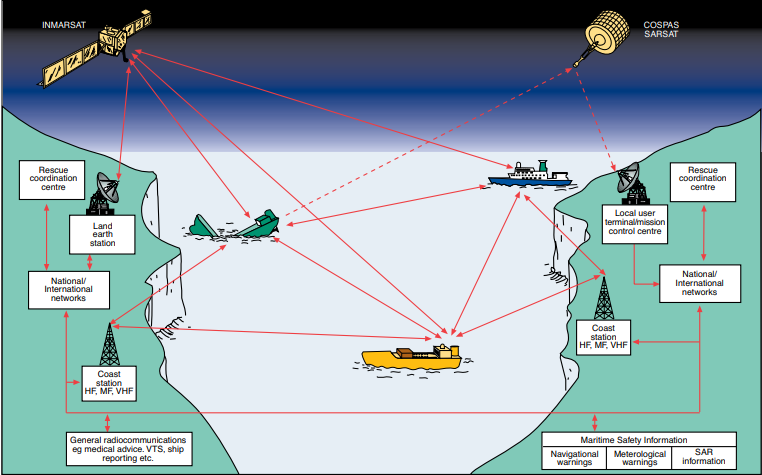
(Australian Maritime Safety Authority, 2013)
Exercises
-
Visit the simulator and use the checklist to detect and familiarise yourself with the different equipment. In pairs, explain the equipment to each other.
-
Write a text where you present two different types of equipment that you are very familiar with, and two that are new to you or that you want to learn more about. This can also be done in pairs. Find reliable sources, and use them actively in your text. Remember to cite your sources correct. Check Chapter 5 or kildekompasset.no for tips.
-
Additional reading: 30 types of Navigation Equipment and Resources used Onboard Modern Ships. Read the article and make at least 10 questions and answers based on the information. When the entire class is finished, quiz each other.
-
GMDSS: Write short descriptions of the different components in the GMDSS
The Weather
Weather conditions
"Oh, the weather outside is frightful, but the fire is so delightful". Unfortunately, there is no delightful fire to gather around when out at sea, but the weather can often be quite frightful. A part of the officer's duties is to be able to describe weather conditions in English. As officers on the navigational watch, you must, in English, be able to:
- describe meteorological conditions
- interpret synoptic charts and meteorological information
- report damage caused by bad weather at sea
Note
It must be emphasized that this section aims to increase the level of meteorological English vocabulary; it is not a course in meteorology.
When describing meteorological conditions, or even just discussing the weather in daily conversations, it is important to be precise and accurate. To say that the weather is poor or frightful, as in the song, is not sufficient in the maritime business. Actually, your meteorological vocabulary should be quite advanced in order to describe and interpret information about the weather, as well as when reporting damage caused by bad weather.
First of all, you need to know the vocabulary in question, and learn it by heart. In chapter 3, you read about the different motions of the ship, and in heavy weather, the ship is subjected to heavy strain and stress (Pritchard, n.d.). Examples of the ship's motions in heavy seas can be heaving, rolling, pitching, surging, yawing, and swaying. The ship can also experience stresses like hogging, sagging, pounding, and pooping.
Do you remember?
Do you remember what these movements are?
If not, look back to chapter 3 for a recap, or check your glossary.
Before we do a proper deep dive into the wonderful pool of meteorological vocabulary, some definitions must be made clear.
The weather side is the side from which the wind is blowing. Say that the wind comes on to the starboard beam, then starboard is the weather side. The leeward side is then the port side of the ship. Leeway is the difference, or distance, between the course steered and the course actually run when the wind is on any part of the vessel's side. Sometimes we say that the ship is running before the sea, and this is the case when the wind and sea are directly astern. This might be dangerous for several reasons (Pritchard, n.d.). Firstly, the ship might be pooped, or broach to, or surf and broach to. The ship is pooped if a following sea crashes on to the sea, and it broaches if it is travelling with the same speed as the waves. When the ship surfs, it actually surfs on the crest of a wave, with its propellers and rudder out of the water.
Wind and precipitation, often combined, are what cause rough weather at sea. Below you can see the Beaufort Scale. As well as the Beaufort scale, you should be able to describe different kinds of precipitation that can be experienced at sea. Precipitation is what we in Norwegian would translate as nedbør, which can refer to a variety of weather phenomena. Merriam Webster defines precipitation as "a deposit on the earth of hail, mist, rain, sleet or snow". Visit the MetOffice's website and learn more.
BEAUFORT SCALE
| Beaufort number |
Name | Knots | m/sec | Effects observed far from land | Average wave height |
|---|---|---|---|---|---|
| 0 | Calm | 0 - 1 | 0 - 0,2 | Sea like mirror | - |
| 1 | Light air | 1-3 | 0,3 - 1,5 | Ripples with appearances of scales; no foam crests | 0,1 m |
| 2 | Light breeze | 4-6 | 1,6 - 3,3 | Small wavelets; crests of glassy appearance, not breaking | 0,2 m |
| 3 | Gentle breeze | 7-10 | 3,4 - 5,4 | Large wavelets; crests begin to break; scattered whitecaps | 0,6 m |
| 4 | Moderate breeze | 11-16 | 5,5 - 7,9 | Small waves, becoming longer; numerous whitecaps | 1 m |
| 5 | Fresh breeze | 17-21 | 8,0 - 10,7 | Moderate waves, taking longer form; many whitecaps; some spray | 2,0 m |
| 6 | Strong breeze | 22-27 | 10,8 - 13,8 | Larger waves forming; whitecaps everywhere; more spray | 3,0 m |
| 7 | Near gale | 28-33 | 13,9 - 17,1 | Sea heaps up; white foam from breaking waves begins to be blown in streaks | 4,0 m |
| 8 | Gale | 34-40 | 17,2 - 20,7 | Moderately high waves of greater length; edges of crests begin to break into spindrift; foam is blown in well-marked streaks | 5,5 m |
| 9 | Strong gale | 41-47 | 20,8 - 24,4 | High waves; sea begins to roll; dense streaks of foam; spray may reduce visibility | 7,0 m |
| 10 | Storm | 48-55 | 24,5 - 28,4 | Very high waves with overhanging crests; sea takes white appearance as foam is blown in very dense streaks; rolling is heavy and visibility reduced | 9,0 m |
| 11 | Violent storm | 56-63 | 28,5 - 32,6 | Exceptionally high waves; sea covered with white foam patches; visibility still more reduced | 11,5 m |
| 12 | Hurricane | 64 and over | 32,7 and over | Air filled with foam; sea completely white with driving spray; visibility reduced | 14 m |
Exercise
- Explain the terms: heaving, rolling, pitching, surging, yawing, swaying, hogging, sagging, pounding, pooping, weather side, leeward say, leeway, broaching, surfing.
- Study the table of the Beaufort scale, find a partner and quiz each other.
-
a) Download and study this glossary.
b) Test yourself without checking with a dictionary: Do you know the correct Norwegian terms?
c) Look everything up in a dictionary, and correct yourself. - Do the Quizlet found here.
Reporting: Abbreviations and symbols
When out at sea, harsh weather conditions can make even the simplest tasks a challenge. Therefore, it is extremely important to pay attention to the shipping forecasts and act accordingly. Forecasts are normally broadcasted over radio or online at set times during the day. The Met Office, for instance, issues a shipping forecast four times a day, at 2300, 0500, 1100, and 1700 UTC. As stated on their website "the forecast contains details of gale warnings in force, a general synopsis and sea-area forecasts containing forecast wind direction and force, weather and visibility" (Met Office, 2013).
Many situations regarding the recording of weather information require the use of specific symbols and abbreviations. These symbols and abbreviations are useful when taking notes from a forecast, understanding and communicating warnings from NAVETX, reading weather charts and routing systems, and filling out the ship's logbook.
When marking weather in the ship's logbook, these abbreviations are used (ibid.)
Weather
| a | Clear or light clouds |
| b | Partly clouded |
| c | Clouded or overcast |
| d | Snow-, dust or sanddrift |
| e | Fog, haze or mist |
| f | Drizzle |
| g | Rain |
| h | Snow or sleet |
| i | Showers or rain, snow, sleet or hail |
| j | Thunder with or without precipitation |
‘p’ denotes showers of, e.g. pg = showers of rain
Capital letters denote intensity e.g. G = heavy rain
Letters repeated denote continuity e.g. GG = continuous heavy rain
‘I’ denotes intermittent (happens sporadic), e.g. ig = intermittent (sporadic) rain
(/) (a backslash) divides present from future weather, e.g. g/h/e = rain followed by snow, then mist
(ibid, p. 114)
Wind direction
Direction of the wind may be given with numbers according to the following scale from 01-36 where 09 indicate wind from the East, 18 from the South, 27 from the West and 36 from the North. Directors shall always be indicated with two figures.
| NNE - 02 | ESE - 11 | SSW - 20 | WNW - 29 |
| NE - 05 | SE - 14 | SW - 23 | NW - 32 |
| ENE - 07 | SSE - 16 | WSW - 25 | NNW - 34 |
| E - 09 | S - 18 | W - 27 | N - 36 |
Visibility
| Symbol | Name | Visibiliy in n.m | Most often occur during |
|---|---|---|---|
| A | Fog or dense snow fall | Less than 0,5 | Very dense or dense fog, snowfall or drizzle |
| B | Poor visibility | 0,5 - 2,0 | Light fog - dense or medium dense haze, snowfall or drizzle, very heavy or heavy rain |
| C | Moderate visibility | 2,0 -5,0 | Medium haze- mist - light snow fall or light drizzle - medium rain |
| D | Good visibility | 5,0 25,0 | Light haze or mist - very light snowfall - drizzle or light rain |
| E | Very good visibility | More than 25,0 | Very light haze or mist - very light rain |
Sea condition
| Symbol | Name | Height in meters |
|---|---|---|
| 0 | Calm (glassy) | 0 |
| 1 | Calm (rippled) | 0 - 0,10 |
| 2 | Smooth (wavelets) | 0,1 -0,5 |
| 3 | Slight | 0,5 - 1,25 |
| 4 | Moderate | 1,25 -2,50 |
| 5 | Rough | 2,50 -4,0 |
| 6 | Very rough | 4,0 - 6,0 |
| 7 | High | 6,0 - 9,0 |
| 8 | Very high | 9,0 - 14,0 |
| 9 | Phenomenal | 14,00 -- |
Also,
| Dir'n | Direction |
| Vis | Visibility |
| Baro | Barometer reading |
 |
Rising pressure |
 |
Steady pressure |
 |
Falling pressure |
Note: The angle of the slanted line equals rate of rise and fall in pressure.
Exercise
Teacher tip: Read a weather forecast and let the students fill in the log. You can find the weather log/report here.
Fill in the forecast form under, using information about today's forecast.
Synoptic weather charts
Synoptic weather charts, or surface pressure charts, help us understand the temperature, air pressure, and weather directions, hence allowing us to be able to forecast the weather in an even more precise way. These synoptic weather charts indicate the movements of cold and warm fronts, high and low pressure as well as several other important pieces of information that can be helpful in determining current and future weather situations.
Use abbreviations for the compass directions (S/N/E/W). For millibars, these letters can be put in front of the figure (Blakey, 1995):
| L | Low pressure, depression |
| W | High pressure, anticyclone |
| T | Through of low pressure |
| R | Ridge of high pressure |
| W | Warm front |
| C | Cold front |
| O | Occluded front |
| S | Secondary front |
First of all, what do you already know about synoptic weather charts? How would you explain the terms occlusion and depression in connection to weather? Do you know the symbols for a warm or cold front when you see a weather chart? Do you know how these things affect the weather?
Watch this video from the Met Office. Can you answer the questions above?
The Met Office provides good, reliable information about weather and is the main source of information in the following section about interpreting weather charts. All symbols and pictures are also found on their website.
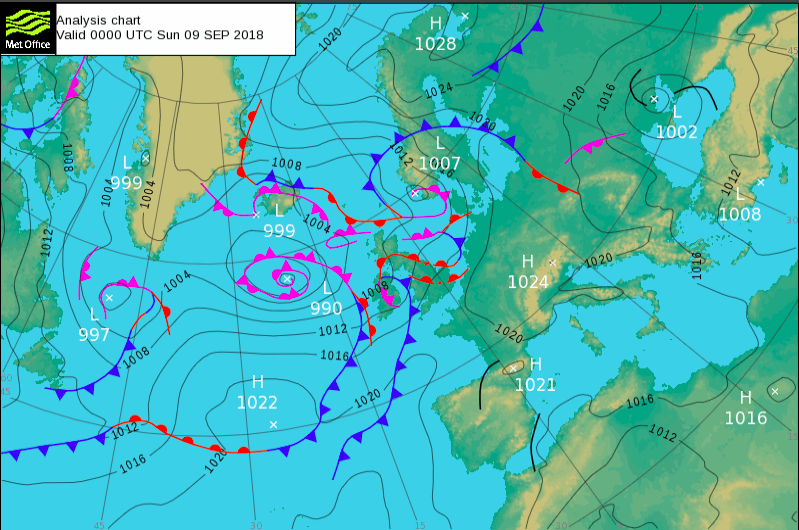
1 ibid.
When you see a surface pressure chart of this type, you can see lines with different distances between them. These are isobars, and they are lines that indicate areas of equal pressure. The pressure pattern shown by the isobar lines denotes a difference of four hPa. Hectopascals are used to measure atmospheric pressure. One hPa is equal to 100 pascals or 1 millibar. You can also see Hs and Ls at different places on the chart. These indicate areas of high or low pressure. As we know, high pressure is often associated with fair weather and no precipitation, while cloudy weather and precipitation generally occurs when there is low pressure. You can also see fronts (different coloured lines with triangles and semicircles), and troughs (thicker black lines) on the chart. These symbols can be very informative if you understand what they represent. Keep reading to find out more about what these symbols mean.
How to read the weather chart
So, what are the weather charts trying to tell us? The Met Office provides the following information and figures in their Understanding Weather Charts (Met Office, n.d.):
Isobars, pressure and wind
Isobars are lines joining points of equal pressure, similar to contours, which are shown on weather charts. Charts showing isobars are useful because they can help to identify anticyclones and depressions. Pressure is measured in millibars, and isobars are normally drawn at intervals of 4 millibars. Pressure values are corrected to Mean Sea Level Pressure (MSLP) before being plotted on a map. This ensures that altitude does not affect the mapping.
Isobars are also helpful because the help us to understand the direction and strength of the wind in a particular area. Where isobars are very close together, for example near a depression, they indicate strong winds. Where the isobars are more widely spaced, near an anticyclone for example, they indicate light winds.
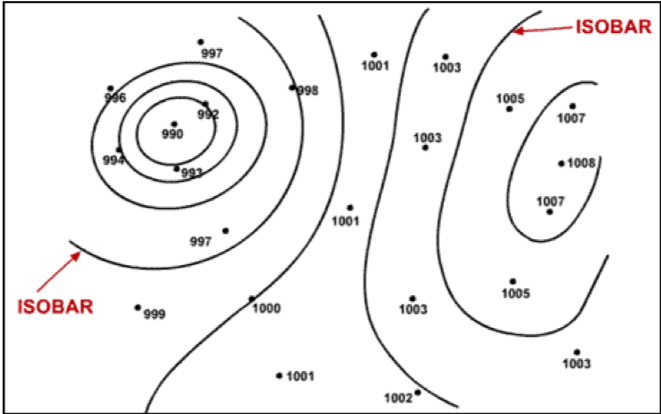
The wind will blow almost parallel to the isobars. Around an anticyclone, the winds will blow slightly across the isobars, away from the centre of the anticyclone. In depressions, the wind will blow slightly across the isobars towards the centre of the low pressure.
Buys Ballot's Law states that if you stand with you back to the wind in the Northern Hemisphere, low pressure will be on your left. This means that you can work out the wind direction at different locations on a weather chart.
Identifying pressure systems and fronts
High pressure - Anticyclones
An anticyclone, also known as a 'high', can oftentimes be identified on a weather chart as a large area of widely spaced isobars, where pressure is higher than surrounding areas. In the Northern Hemisphere, winds blow in a clockwise direction around high pressure. The highest pressure occurs at the centre and is known as the 'high pressure centre'. Anticyclones can bring warm and sunny weather in summer and cold and foggy weather in winter.
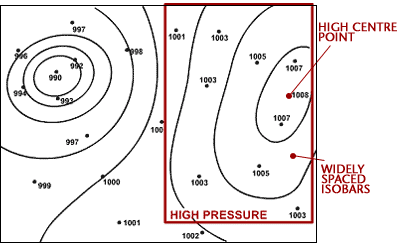
Low pressure - Depressions
A depression, also known as a 'low', can be recognized on a weather chart by an area of closely spaced isobars, often in a roughly circular shape, where pressure is lower than surrounding areas. In the Northern Hemisphere, winds blow around depressions in an anticlockwise, or counterclockwise, direction. The lowest pressure occurs at the middle of a depression, known as the 'low pressure centre'. Depressions are often associated with strong winds and heavy rain and are nearly always accompanied by fronts.
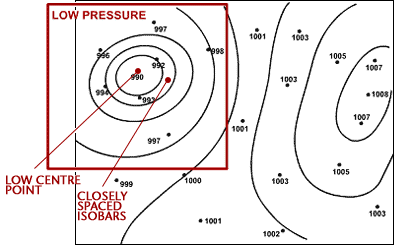
Troughs
Troughs
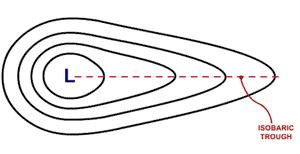
Troughs are elongated extensions of areas of low pressure. They bring similar weather to that associated with depressions.
Ridges
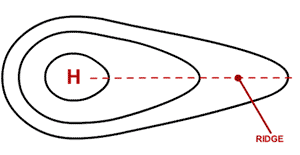
Ridges are elongated extensions of areas of high pressure. They bring similar weather to that associated with anticyclones.
Col
A col can be identified as an area of slack pressure between two anticyclones and two depressions.
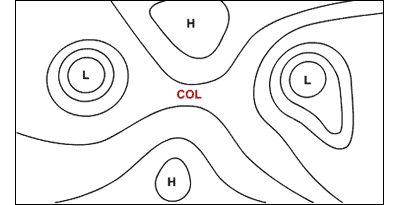
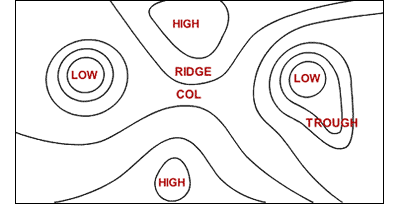
Cold fronts and warm fronts
Cold fronts can be identified on weather charts as bold lines with triangles. These are blue when displayed on colour charts. The points of the triangle indicate the direction in which the front is moving. A cold front indicates a change in air mass, where warmer air is being replaced by colder air. They often bring short spells of heavy rainfall in the form of showers and squally winds and are accompanied by a decrease in temperature, a veer in wind direction and a change to brighter, showery conditions.
Warm fronts can be identified on weather charts as bold lines with semi-circles or humps. These are coloured red when displayed on colour charts. The direction of the humps indicate the direction in which the front is moving. A warm front indicates a change from a colder to a warmer air mass. They often bring spells of prolonged and sometimes heavy rainfall with strong winds.
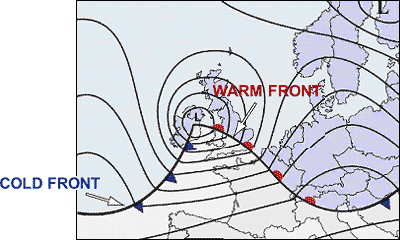
Occluded fronts
Occluded fronts can be identified on weather charts as bold lines with sets of triangles and semi-circles. These are coloured purple on coloured weather charts. The direction in which the symbols are pointing indicates the direction in which the front is travelling. Occlusions are formed when the cold front overtakes the warm front. They therefore have similar characteristics to a cold front, only less intense.
Warm Sector
The warm sector of a depression is located behind the warm front and ahead of the cold front. It often brings mild temperatures, but the weather can be overcast with drizzle.
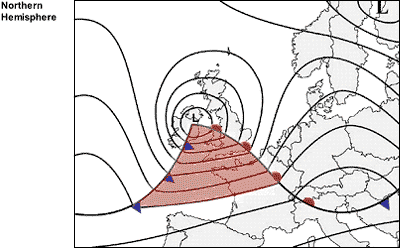
Symbols on the surface pressure charts
The following symbols are some of the most common you will come across when working with surface pressure charts.
| Image/Symbol | Explanation |
|---|---|
 |
Cold front The leading edge of an advancing colder air mass. Its passage is usually marked by cloud and precipitation, followed by a drop in temperature and/or humidity. |
 |
Occluded front (or 'occlusion') Occlusions form when the cold front of a depression catches up with the warm front, lifting the warm air between the fronts into a narrow wedge above the surface. Occluded fronts bring cloud and precipitation. |
  |
Developing cold/warm front (frontogenesis) Represents a front that is forming due to increase in temperature gradient at the surface. |
  |
Weakening cold/warm front (frontolysis) Represents a front that is losing its identity, usually due to rising pressure. Cloud and precipitation becomes increasingly fragmented. |
  |
Upper cold/warm front Upper fronts represent the boundaries between air masses at levels above the surface. For instance, the passage of an upper warm front may bring warmer air at an altitude of 10,000 ft, without bringing a change of air mass at the surface. |
 |
Quasi-stationary front A stationary or slow-moving boundary between two air masses. Cloud and precipitation are usually associated. |
 |
Isobars Contours of equal mean sea-level pressure (MSLP), measured in hectopascals (hPa). MSLP maxima (anticyclones) and minimal (depressions) are marked by the letters H (High) and L (Low) on weather charts. |
 |
Thickness lines Pressure decreases with altitude, and thickness measures the difference in height between two standard pressure levels in the atmosphere. It is proportional to the mean temperature of this layer of air, so is a useful way of describing the temperature of an airmass. Weather charts commonly show contour lines of 1,000-500 hPa thickness, which represent the depth (in decametres, where 1 dam = 10 m) of the layer between the 1,000 hPa and 500 hPa pressure levels. Cold, polar air has low thickness, and values of 528 dam or less frequently bring snow to the UK. Conversely, warm, tropical air has high thickness, and values in excess of 564 dam across the UK often indicate a heatwave. |
 |
Trough An elongated area of relatively low surface pressure. The troughs marked on weather charts may also represent an area of low thickness (thickness trough), or a perturbation in the upper troposphere (upper trough). All are associated with increasing cloud and risk of precipitation. |
 |
Convergence line A slow-moving trough, which is parallel to the isobars and tends to be persistent over many hours or days. They are quite common in cold northerly outbreaks down the Irish Sea, affecting west Wales, Devon and Cornwall in particular, but can be found in other areas also. This convergence line can give hours of persistent precipitation over very localised areas, whilst a few miles down the road it is relatively dry, leading to some heavy snowfall/rainfall. In summer the convergence lines are not as easy to forecast, but then can still occur due to sea-breeze convergence, and are over the land, whilst in winter they are over the sea. |
Exercises
-
Print the chart, and label each symbol with the correct term.
-
Look at a chart from today, e.g. the one you find on the Met Office website.
a. What can you see on the map?
b. What can this tell us about the weather?
c. How would today's weather affect navigation and course plotting/charting? -
In pairs, explain the weather charts to each other.
-
Practice communicating about weather conditions with a partner using SMCP AI/3.1 Meteorological and hydrological conditions.
a. Before you start, read through the SMCP and chose your cardinal points, met. Area, storm name, etc.
b. When you finish with AI/ 3.1, practice using the following
i. A1.6.2 Phrases for providing VTS services
1. .1.7 Meteorological warnings
2. .1.8 Meteorological information
3. .1.9 Meteorological questions and answers
ii. ON BOARD COMMUNICATION PHRASES B.1. 1.5 Briefing on meteorological in conditions
SMCP: Meteorological conditions
AI/3.1 Meteorological and hydrological conditions
A1.6.2 Phrases for providing VTS services
.1.7 Meteorological warnings
.1.8 Meteorological information
.1.9 Meteorological questions and answers
ON BOARD COMMUNICATION PHRASES
B.1. 1.5 Briefing on meteorological in conditions
Academic writing: Accident, incident and near miss reports
You are obliged to report accidents, incidents and near misses. According to NMA (Norwegian Maritime Authority , 2012) the shipmaster or the shipping company shall immediately notify The Joint Rescue Coordination Centre [verbally] in case of, inter alia, the following:
- loss of ship or life
- considerable personal injury or severe damage to the vessel
- work accident when evacuation of the injured person is required
- emissions or probable emissions of oil or hazardous substances
- fire, explosion, collision or similar
- when a ship has run aground or collided (ibid)
In addition to a notification to The Joint Rescue Coordination Centre, any Norwegian coastal radio station shall be notified when there is need for assistance or risk of emission.
The shipping company or the shipmaster shall report in a designated form within 72 hours. The form is found here. The following lists the different marine occurrences that must be reported.
Marine occurrences to be reported
| Type | Description |
|---|---|
| Very serious marine casualty | - loss of vessel - loss of life -severe damage to the environment - or a passenger ship was in imminent danger of the above. |
| Marine casualty | - significant injury. Significant injury is defined as an injury resulting in loss of normal ability to work for more than 72 hours if the loss of ability is noticeable within seven days of the accident. The vessel: - is lost or assumed to be lost; - is abandoned; - is significantly damaged; A vessel is considered significantly damaged if the damage affects the structural integrity, performance or operation of the vessel and this necessitates a major repair or replacement of one or more important parts, or if the damage leads to technical loss of vessel. - has grounded or been involved in a collision or any other occurrence that incapacitates the vessel. |
| Serious casualty with a vessel | An accident involving fire, explosion, collision, contact, heavy weather damage, ice damage, hull cracking, or suspected hull defect, etc., resulting in: - immobilisation of main engines, extensive accommodation damage, severe structural damage, such as penetration of the hull under water, etc., rendering the ship unfit to proceed; - pollution; or - a breakdown that necessitates towage or shore assistance. |
| Type | Description |
|---|---|
| Other vessel accidents | Groundings or collisions not regarded as serious casualties, marine casualties or very serious casualties. Grounding: - any accidental contact between vessel and ground, regardless of extent of damage. Collision: - any collision between vessels, regardless of extent of damage; Contact: - any contact with fixed objects, quays and installations where either vessel or object is damaged to an extent which interrupts normal operation. |
| Pollution or risk of pollution | - discharge or probable discharge above the permitted level pursuant to MARPOL 73/78 of oil or noxious liquid substances for whatever reason; - loss/discharge or probable loss/discharge of dangerous or harmful substances in packaged form, including substances in portable tanks or tank vehicles, and where vehicles, freight containers or other cargo transport units contain packaged goods; - discharge or probable discharge of dangerous chemicals or dangerous liquefied gases. |
| Type | Description |
|---|---|
| Occupational accident | An accident where a person working on board has been injured while working. Injuries to be reported are: - loss of normal ability to work for more than 72 hours if the loss of ability is noticeable within seven days of the accident; or - of a serious nature. Be aware that an injury might be more serious than deemed at first assessment. If the injury is not previously reported, it must be reported to the NMA as soon as possible. The following list may be helpful when determining whether an injury should be reported: - head injuries/concussions leading to loss of consciousness or other serious consequences - fractures (except single fractures on fingers or toes); - internal injuries (damage to internal organs); - loss of limb; - poisoning; - loss of consciousness due to work-related factors (such as lack of oxygen); - burns, frost injuries or chemical burns (all third-degree burns, second-degree burns on face, limbs and genitals, second-degree burns on 5% or more of skin surface); - hypothermia; - injuries that hospitalise the injured person. |
(Norwegian Maritime Authority , 2018)
First Aid
Learn more about injuries and First Aid on board in chapter 6.
Exercise
Fill in the Maritime casualty report. Use the vessel particulars of a vessel used in a simulator exercise.
GRAMMAR
Comma use
When and where to use a comma in an English language text can cause confusion for even the most confident English speaker. Commas are a necessary part of writing in English. They allow the writer to combine ideas and information, insert pauses, and differentiate between elements in a sentence.
The following covers the most common comma rules and examples that you will encounter. If you are wondering about comma use when joining sentences together, refer to chapter x's grammar section on conjunctions and transition words.
The table below outlines the different topics involving comma use dealt with in this section. Click on a topic to find out when and how you need to use commas.
Curious about commas?
| Lists The Captain can speak English, Dutch, and Norwegian. |
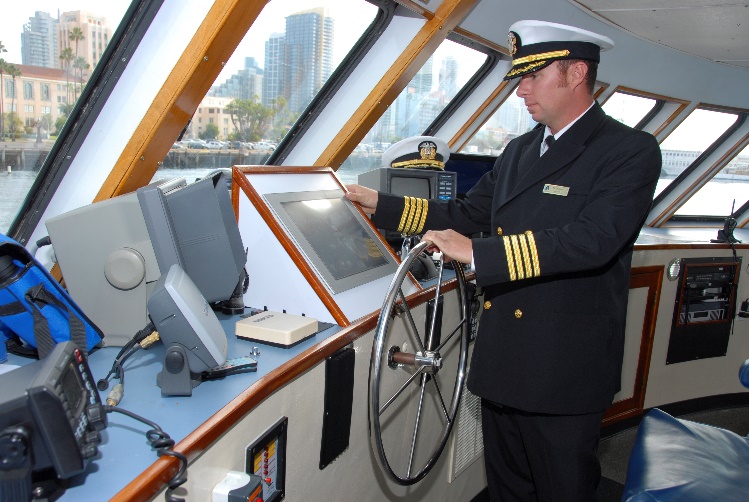 |
| Extra information Sailing in busy ports, like the Port of Hong Kong, requires effective communication. |
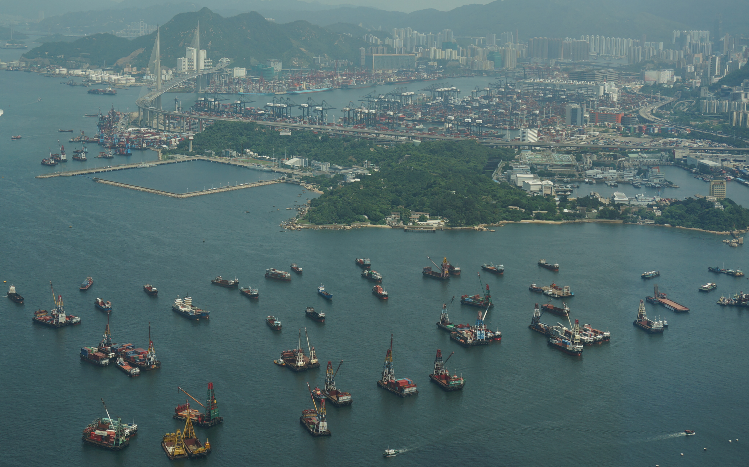 |
| Numbers and dates This professional exchange between naval officers took place on October 30, 2009. |
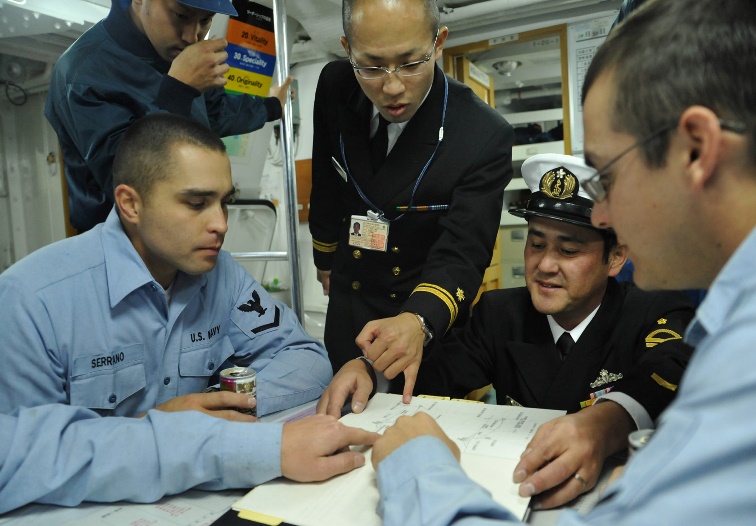 |
| Conditional sentences If the ship were to encounter heavy weather, the cargo should remain secure. |
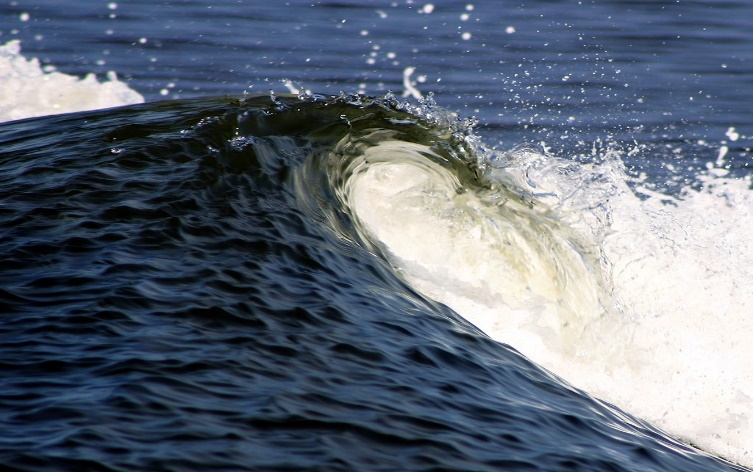 |
| Subordinating conjunctions and prepositional phrases at the beginning of a sentence While sailing off the coast of Somalia, MV Faina was hijacked by pirates. |
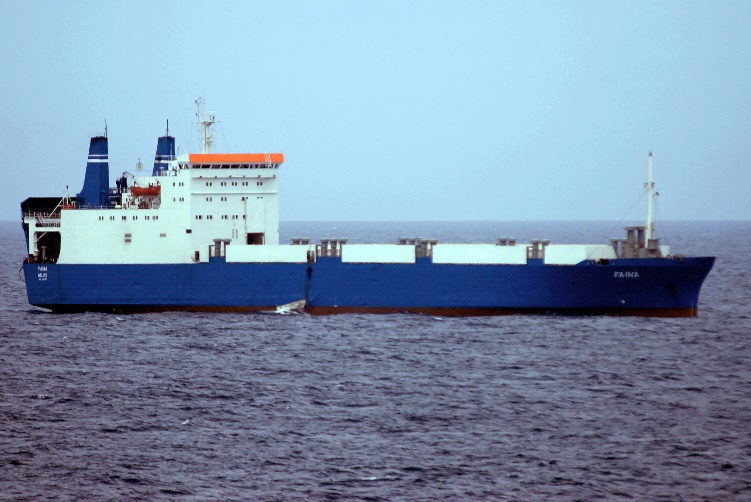 |
| Direct speech >«We need to perform a spot-check in the engine room, Tony.» |
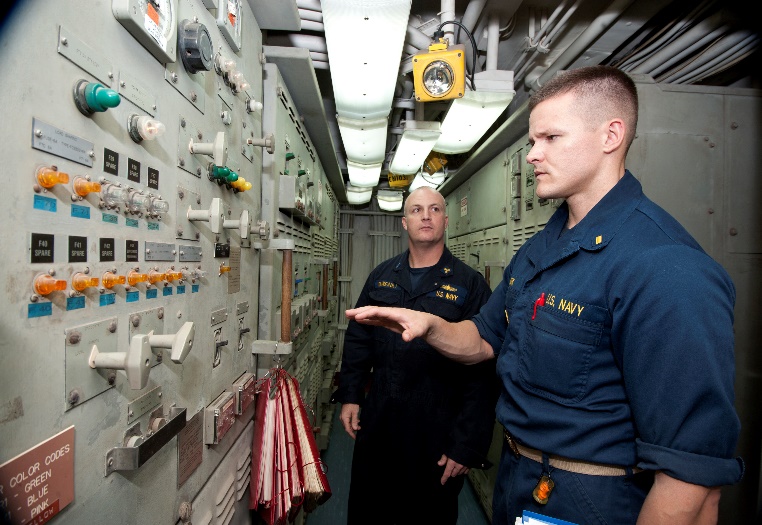 |
| Place names San Francisco, California is home to a large port facility. |
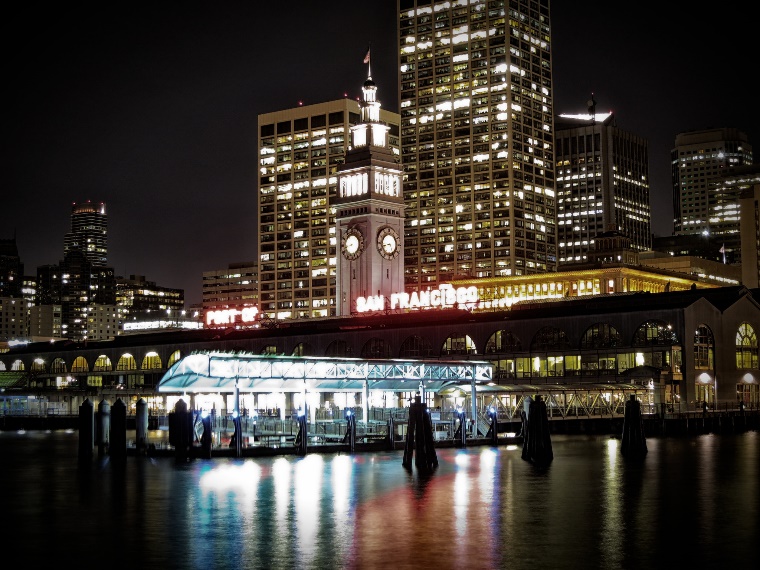 |
Lists
Commas are needed when making a list of more than two things or actions. Notice in the examples below that the commas are placed after each item in the list.
Examples
- The Captain, Bosun, and First mate attended the meeting.
- She excelled at running, swimming, and singing.
- The cargo was comprised of wine, fruit, and shrimp.
- He ran, biked, and climbed to prepare for his marathon.
The Oxford comma
The Oxford comma
There are different approaches to comma use when listing things in a sentence. Using a comma before the coordinating conjunction (i.e. and, or, but) as you see in the examples above is commonly known as the Oxford comma. Others refer to the comma as the serial comma or the Harvard comma, and its use and purpose are heavily debated. Consider the picture below- how does comma placement affect the reader's understanding of the sentence? Watch out this Ted-Ed video to find out more!
Image courtsey of The Gloss.
Coordinate adjectives
Commas can also be used to separate two adjectives describing the same noun (coordinate adjectives).
Examples
- The vessel Pacific Rim is a large, ancient tanker.
- Hong Kong is home to a gigantic, modernized port.
Extra information
A comma or commas should be used when you add extra non-essential information to a sentence.
Examples
- The Captain disliked sailing through the Strait of Malacca, a heavily trafficked fairway.
The phrase heavily trafficked fairway gives you additional information about the Strait of Malacca, but it is not essential in helping the reader understand the sentence.
- The trawler, prone to listing during high winds, almost capsized near the shoal.
In this sentence, prone to listing during high winds gives you extra information about the trawler. As in the previous sentence, the meaning of the sentence can be understood without this phrase.
- Illegally discharging waste overboard, which is strictly regulated by MARPOL, can result in serious consequences, such as fines or prison sentences.
Read the sentence above without the information in bold. Does it still make sense? Commas allowed the writer to add extra information for the benefit of the reader.
Numbers and dates
Another problematic area for non-native English speakers (and many native English speakers!), is writing numbers and dates.
Numbers
Commas are typically used when writing numbers greater than 1,000. The comma divides the numerical expression and helps the reader to determine if the number in question is in the thousands, millions, or billions.
Examples
- One thousand: 1,000
- One million: 1,000,000
- One billion: 1,000,000,000
If you are familiar with the Norwegian numerical system, you might notice that the use of commas in numerical expressions is the exact opposite of what is done in Norwegian. In Norwegian, numbers 1,000 or more are written with a decimal point and not a comma. When writing numerical expressions in English that include fractions or monetary expressions that include cents, a decimal point must be used. This is the opposite how these expressions are written in Norwegian, where a comma is used to express fractions and cents/change.
Examples
0.05
0.25
$50.04
£10.20
Dates
Writing dates in English is not as complicated as one might think. British English dates are written much the same as Norwegian dates, with the exception of the name of the month, which is written in English. The British English way of date writing does not include a comma. However, American English dates require a comma as they feature the month before the day and the year. Below is a table with examples of how dates are written in both American and British English. Note that this is how dates should be written out in texts. When writing the date on a cover page or in the date section of a report, abbreviations can be used, e.g. dd.mm.yyyy, mm.dd.yyyy, dd-mm-yyyy, mm-dd-yyyy, dd/mm/yyyy, mm/dd/yyyy.
Examples
| British English | American English |
|---|---|
| 21 March 1984 | March 21, 1984 |
| 21st March 1984 | March 21st, 1984 |
| the 21st of March, 1984 | the 21st of March, 1984 |
| Wednesday, 21 March 1984 | Wednesday, March the 21st, 1984 |
| Wednesday the 21st of March, 1984 | Wednesday, March 21, 1984 |
The st you see after the number 21 refers to the date being the twenty-first. If you choose to write the date using an ordinal indicator, e.g. 21st, you must use the appropriate suffix.
Examples
- 21st - first
- 22nd - second
- 23rd – third
- 24th – fourth
How you write a date is often a stylistic choice. Ask your instructor which style you should use before choosing either the American or British English method, and remember to be consistent after you have chosen one or the other.
Conditional sentences
"If I finish reading Chapter 5, I can go out for a beer." Maybe you have said something like this to yourself at some point during the school year. This sentence presents you with a condition- if you do one thing, then another thing can be done or happen. If you start a sentence with a conditional If clause, you must use a comma.
Examples
– If the engine is not repaired by tomorrow, we will be behind schedule.
– If there is an oil spill, the environment could be irreparably damaged.
These kinds of sentences do not require a comma if they do not start with the if clause.
We will be behind schedule if the engine is not repaired by tomorrow.
The environment could be irreparably damaged if there is an oil spill.
Subordinating conjunctions and prepositional phrases at the beginning of a sentence
If you are wondering what a subordinating conjunction is or does, look no further than this very sentence. The subordinating conjunction "if" was used in the above sentence to turn two sentences into one.
Example
You are wondering what a subordinating conjunction is or does.
+
Look no further than this very sentence.
=
If you are wondering what a subordinating conjunction is or does, look no further than this very sentence.
Using "if", these two sentences are joined together. Notice how the sentence using "if" has a better flow than the two sentences on their own. Subordinating conjunctions are a useful tool in advanced writing in English.
Why are these called subordinating conjunctions? In the example above, "if" is used to turn one sentence into a subordinate clause. This in turn emphasizes the importance of the second sentence. Whenever you use a subordinating conjunction, you not only connecting ideas, but emphasizing them. Read in chapter x to find out about coordinating conjunctions which are used to connect to similar and equal ideas.
Look at the table below. These are examples of some of the most common subordinating conjunctions, many of which you have probably seen and heard before.
| Subordinating conjunction | Example |
|---|---|
| After | He eats dinner after he gets home from work. |
| Although | Although she is never sick, she often misses work. |
| As (as soon as, as long as) | I will call you as soon as I am home. |
| Because | The First Officer panicked because the Captain had fallen asleep. |
| Before | Clean your workstation before you leave. |
| During | During class, you cannot use your phone. |
| Even though | Even though you have a lot of experience, you can always learn new things. |
| If | If you miss work, you might be fired. |
| In order to | She must speak English in order to become an officer. |
| Since | Since the marine environment is vulnerable, we must prevent pollution. |
| Though | He has many friends though he is often homesick. |
| Unless | The expected date of arrival is tomorrow unless we encounter bad weather. |
| Until | Until an alternative is discovered, diesel fuel must still be used. |
| When | When working at heights, proper personal equipment is necessary. |
| Whenever | The crew is always excited whenever they reach a new port. |
| Wherever | Wherever you go, there you are. |
| While | While you are in class, it is important to concentrate. |
Look at the example sentences above. Some sentences have a comma and others do not. Are you able to recognize a pattern? Two "rules" should be apparent from the above examples:
- Sentences starting with a coordinating conjunction always use a comma at the end of the subordinate clause.
- Commas are never used before a subordinating conjunction if it appears in the middle of a sentence.
Some of the subordinating conjunctions above are also prepositions (before, after, until). When you start a sentence with a prepositional phrase, a comma is necessary. If you are unsure about the difference between a prepositional phrase and a subordinate clause, just remember that clauses have a subject and verb, and phrases do not. Another important thing to remember is that subordinating conjunctions join sentences together, and prepositions indicate a relationship between words and ideas in a sentence.
Direct speech
Commas are also used when indicating direct speech. This most often appears in literary texts when the author writes out dialogue. Reports that feature conversations might also write out direct speech. Direct speech and dialogue indicate that someone is being addressed or spoken to in the sentence.
Examples
- "Play it again, Sam."
- "We quit at noon on Fridays, right?"
- "I have had enough, Truls."
- "Loading completed, Captain."
The above examples also use quotation marks ("). These are also necessary when indicating direct speech or dialogues in formal texts.
Look at the image below. Which statement is direct speech and which is not? How does the comma change the meaning of the sentence?
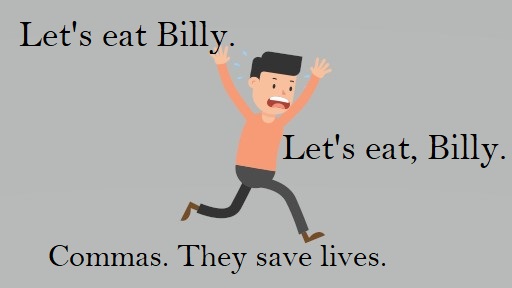
Image courtesy of Videoplasty.com
If you said that "Let's eat, Billy" is an example of direct speech, you are correct. "Billy" is being told that it is time to eat by the speaker/writer, but without the comma you leave Billy wondering if he is about to be grilled or fried.
Place names
Commas are also an important part of writing certain place names. Knowing when to include commas when writing place names will be necessary when writing reports. Commas are necessary when separating city names and states or regions as well as city names and countries.
Examples
- The ship sank off the coast of Galveston, Texas.
- The company operates out of Kristiansund, Norway.
- The fishing vessel Mako departed San Remo, Victoria.
Exercise
Read the following report and correctly place commas where necessary.
At 2000 on 12 August 2017 the fishing vessel Mako departed San Remo Victoria bound for fishing grounds about 3 hours away. Once clear of Cape Woolamai Mako maintained a steady course (210°) and speed to the south-west. At the same time the container ship Glasgow Express was passing Cape Liptrap heading north-west. The ship was bound for Melbourne Victoria and was maintaining a steady course (299°) and speed. From about 2030 the vessels were on a collision course.
No avoiding action was taken by either vessel and at about 2246 they collided.
The ATSB (Australian Transport Safety Bureau) found that a proper lookout by ‘all available means’ was not being maintained on either vessel.
Glasgow Express’s bridge team saw and monitored Mako visually from about 2200. However a full appraisal of the situation using other instruments or means available on the bridge (such as radar) was not done. As a consequence the situation was misinterpreted and the risk of collision was not identified. Therefore no avoiding action was taken.
Prior to handing over the watch at 2230 Mako’s watchkeeper identified Glasgow Express by radar and visually. However the information was misinterpreted and it was concluded that the Glasgow Express was passing clear ahead of the fishing boat and no avoiding action was taken. Then after taking the watch Mako’s second watchkeeper did not see the Glasgow Express until moments before the collision.
In addition Mako was under way with all external lights on. This made the vessel more easily seen but reduced the ability for Glasgow Express’s bridge team to accurately visually appraise the situation. The bright lights also reduced Mako’s watchkeeper’s night vision and ability to distinguish features beyond the glare of the lights.
The ATSB also noted that Mako similar to other fishing vessels of this design had a large fishing net winch drum mounted on deck forward of the wheelhouse. This winch drum restricts forward vision and may limit the ability to maintain a proper lookout unless accounted for in on-board procedures and training.Edited.
Source: https://www.atsb.gov.au/publications/investigation_reports/2017/mair/333-mo-2017-007/
Bibliography
- Australian Maritime Safety Authority. (2013). Australian Global Maritime Distress and Safety (GMDSS) Handbook.
- Bhattacharjee, S. (2017, 06 16). What are the primary duties of an OOW. Retrieved from marineinsight.com: http://www.marineinsight.com/marine-navigation/what-are-the-primary-duties-of-officer-on-watch-oow-on-ships-bridge/
- Bhattacharjee, S. (2017, 09 28). What is Electronic Chart Display and Information System (ECDIS)? Retrieved from Marine Insight: https://www.marineinsight.com/marine-navigation/what-is-electronic-chart-display-and-information-system-ecdis/
- Blakey, T. N. (1995). English for maritime studies.
- Chopra, K. (2017, 05 16). 30 types of-navigational equipment and resources used onboard modern ships. Retrieved from marineinsight.com: http://www.marineinsight.com/marine-navigation/30-types-of-navigational-equipment-and-resources-used-onboard-modern-ships/
- IMO. (2014). ISM CODE . London: International Maritime Organization.
- International Chamber of Shipping. (2016). Bridge Procedures Guide. London: Marisec Publications.
- Maritime and Coastguard Agency, in the United Kingdom. (2017). Retrieved from mcga.gov.uk: https://mcanet.mcga.gov.uk/public/c4/solas/solas_v/Annexes/Annex06.htm#mca
- Met Office. (2013). Met Office UK. Retrieved from https://www.metoffice.gov.uk/guide/weather/marine/shipping-forecastMet Office. (n.d.). Retrieved from Weather charts, Factsheet 11, Interpreting weather charts: https://www.metoffice.gov.uk/binaries/content/assets/mohippo/pdf/library/factsheets/factsheet_11_weather_charts.compressed.pdf
- Met Office. (n.d.). Retrieved from Undestanding Weather Charts : http://www.metlink.org/wp-content/uploads/2013/11/teachers/understanding_weather_charts.pdf
- Norwegian Maritime Authority . (2012, 02 28). Retrieved from https://www.sdir.no/en/shipping/accidents-and-safety/reporting-of-marine-casualties-and-occupational-injuries/
- Norwegian Maritime Authority . (2014). Regulations of 5 September 2014 No. 1157 on navigation and navigational aids for ships and mobile offshore units. Oslo: Regjeringen.
- Norwegian Maritime Authority . (2018, 01 15). Retrieved from https://www.sdir.no/en/guides/guidance-note---notification-and-reporting-of-marine-casualties-and-incidents/
- Pritchard, B. (n.d.). Meating heavy weather. Rijeka, Croatioa.
- Seagull AS. (2011, 03). Techical English for Deck Cadets.
- Sjøfartsdirektoratet. (1999). Maritime Standarduttrykk. Oslo: Universitetsforlaget.
- van Dokkum, K. (2013). Ship Knowledge. Enkhuizen: DOKMAR Maritime Publishers BV.
- Watch System. (2017, 08 05). Retrieved from Wikipedia: https://en.wikipedia.org/wiki/Watch_system#Traditional_system
- Wikipedia. (2017, 06 29). wiki/Seafarer\'s professions and ranks. Retrieved from Wikipedia: https://en.wikipedia.org/wiki/Seafarer%27s_professions_and_ranks#

